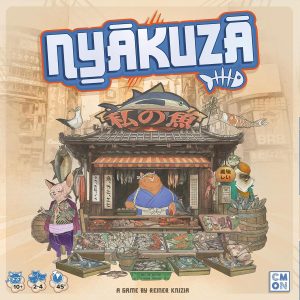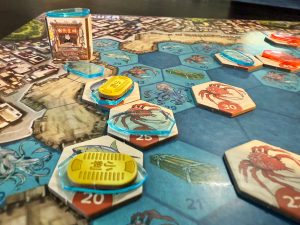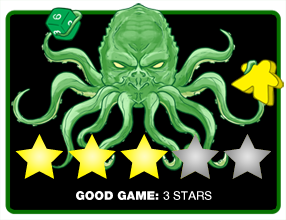 Everyone’s trying to muscle in on some territory these days. It could be CMON reprinting a classic Reiner Knizia design with a fresh set of paint. It could be the retheme itself, as players take on the role of cat yakuza, cornering the fish market in Japan.
Everyone’s trying to muscle in on some territory these days. It could be CMON reprinting a classic Reiner Knizia design with a fresh set of paint. It could be the retheme itself, as players take on the role of cat yakuza, cornering the fish market in Japan.
And while getting an out-of-print design back into the hands of consumers is certainly a flex, does Nyakuza’s retheme improve upon the original? Or is this all a big hustle?
Gameplay Overview:
The goal in Nyakuza is to be the first to build the grand market stall. Two-to-four players receive several basic stalls that must be completed before they can attempt the final build. The systems that pave the way for success emerge via resource tiles that slowly enter play, as well as a simultaneous bid for boats and turn order.
Before bidding starts, the initial setup places a set number of starting tiles onto the board. The main board features numbered hex spaces that correspond to tiles selected from the resource bag. Numbers range from one to sixty and feature certain resource types: driftwood, salmon, tuna, octopus, squid, and crab. In a two or three-player game, specifically, six tiles are drawn randomly before play begins. Each subsequent round reveals three new tiles.

After tiles are revealed each round, players then determine how much they want to bid. Starting coin is determined by player count. Players select their coin bid from behind a screen, reveal at the same time, and several factors are determined from these choices.
The highest bidder receives three boats to place onto the board. The highest bidder must place their coin on the wharf, whereas all other bids are retained by those players. Second place receives two boats, and all other bids receive one boat. If any players bid zero, which is a valid option, they gain the coins available on the wharf, shared equally.
The player with the highest bid places their boats first. Valid placement includes resource tiles that have been added to the board, and open sea and shore spaces if adjacent to one of your boats. The goal is to find placement spaces that provide a path to building stalls. Stalls are built on shore spaces you’ve acquired if you meet the required grouping of resources.

For example, one grouping is to have boats on a salmon and tuna, combined with a shore space. At any moment that this is true, you immediately build a stall on that shore space. Players must also add their coin to the resource tiles to indicate that they have been used and cannot be used again. This coin is pulled from the game’s economy, making it harder to obtain coins for everyone.
If at any point a player can build a stall but does not have the necessary coin for the resource spaces, they must forego placing one of the boats that makes this connection until later rounds when they can afford it (if the space is still available). Thus, funds are important, and bidding is tense, as is the pressure surrounding the zero bid to gain more coins.

Game Experience:
Nyakuza features a four-page rule book that explains everything very clearly. As with many of Knizia’s excellent designs, the rules get out of the way and allow the design to flourish with repeat plays. And like many of Knizia’s classic releases, this design truly sings when everyone at the table has a couple of games under their belt.
I love closed economy games. Couple that with a bidding system that finds you losing funds as you near the final grand stall build provides a tight decision space. It matches the tension one should feel as rival yakuza clans battling for the best resource locations. The closed economy keeps games close, favors those who are watching others’ decisions, and showcases great moments of frustration and elation.

The main board looks great as tiles enter play and each resource tile has great illustration. You can see that there was some thought that went into the redesign in this regard. And yet, this is also where the trouble begins.
Nyakuza was originally released as Orongo in 2014. The original theme was Easter Island and had its own share of component woes. Which makes me wonder if publisher CMON gave this new release the proper attention that it should deserve. Let me explain.
The main board does not utilize its space well. There is a large portion that is just water away from the main area of play. It is truly wasted potential for increasing the hex size and giving the play space a little breathing room. Tiles and boat/coin placement, as well as the stalls (we’ll get to these in a moment), all fight with their horizontal (placement) or vertical (stacking) neighbors.

The cardboard stalls attempt to be a cute thematic touch, but their square shapes do not fit well onto the hex spaces, and the only way to indicate that the stall is yours is to stack a boat on top of the stall once completed. It makes no sense. Hex-shaped mini-stalls may have cost more to produce, and yet would have made this a much cleaner system. Cost vs. functionality. The cat yakuza may understand.
This brings us to the glaring issue. The plastic boat tokens are see-through and colored blue, red, green, and purple. There was thought about making the tiles underneath visible (so you know what you’re trying to collect for stall builds), but once placed on the board, it becomes very hard to know which boats are yours unless you have optimal lighting. In fact, as someone who is color-blind, the boat tokens were hard to even separate into their own matching piles.

The boat tokens may be one of the worst components I’ve encountered in a modern release. For me, and all others I’ve played with, they are unusable. As such, I’ve had to take old game components (cubes and tiles) that work as proxies for both boats and the stalls. These make play tolerable. Ultimately, the production takes a 4.5-star system and throws it right out the window. CMON really dropped the ball on this one.
Final Thoughts:
Classic Knizia meets modern lack of respect. Nyakuza could’ve been an excellent revision of the original. It could’ve been a success story like the newest release of Ra. Now I’m not saying that Nyakuza is in the same tier as Ra, but it would certainly stay on my shelf if I didn’t have to make the game functional on my own. My final rating is generous due to how wonderful the original design is, despite a release that tries very hard to stifle this. Now we may have to wait another ten years before we get another chance to see this system find a producer willing to provide a little respect.
Final Score: 3 stars – Outstanding game design meets unfortunate production design. Nyuck.
 Hits:
Hits:
• Excellent bidding system
• Closed economy
• Slow reveal of tiles
Misses:
• Component woes
• Main board design
• Did I mention those components?
Source: Board Game Quest




